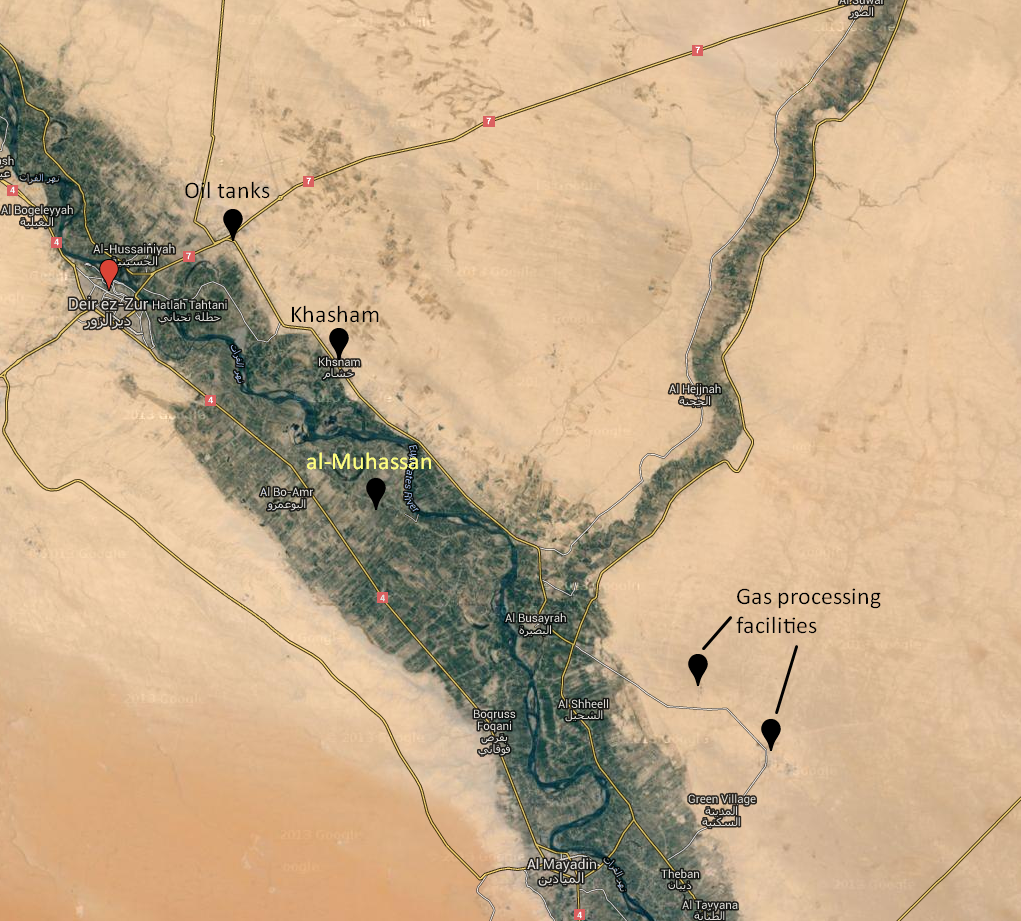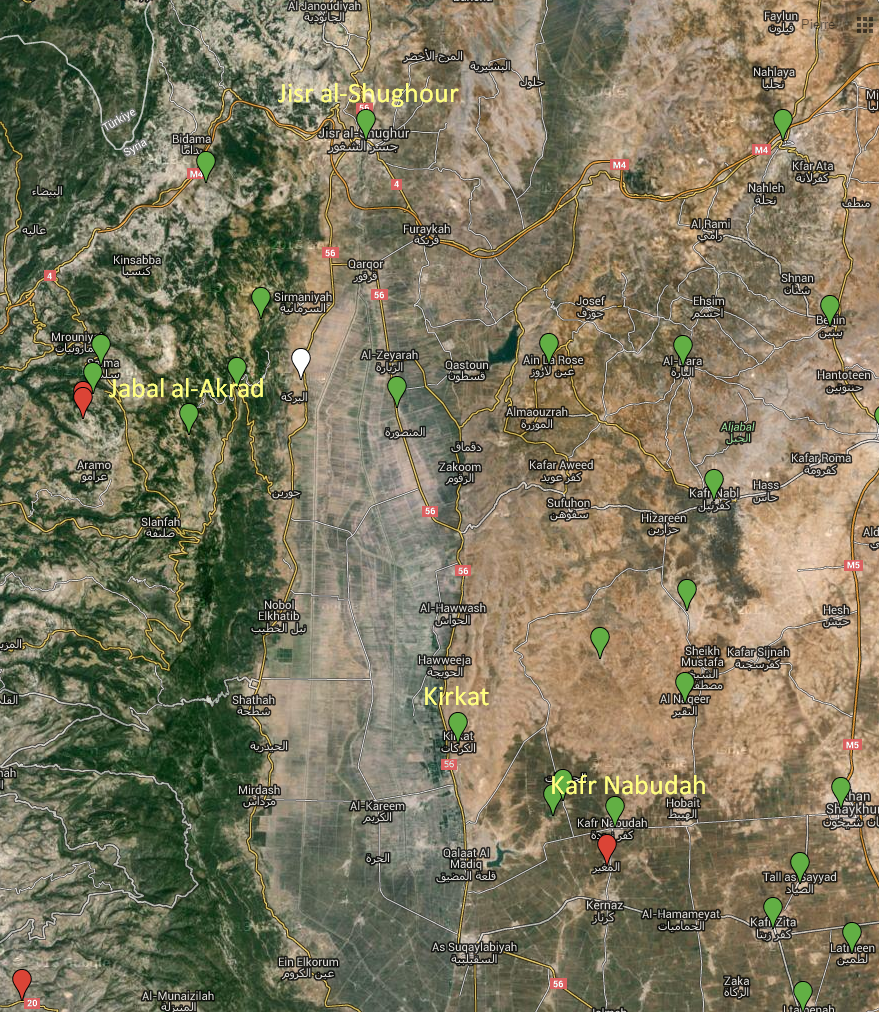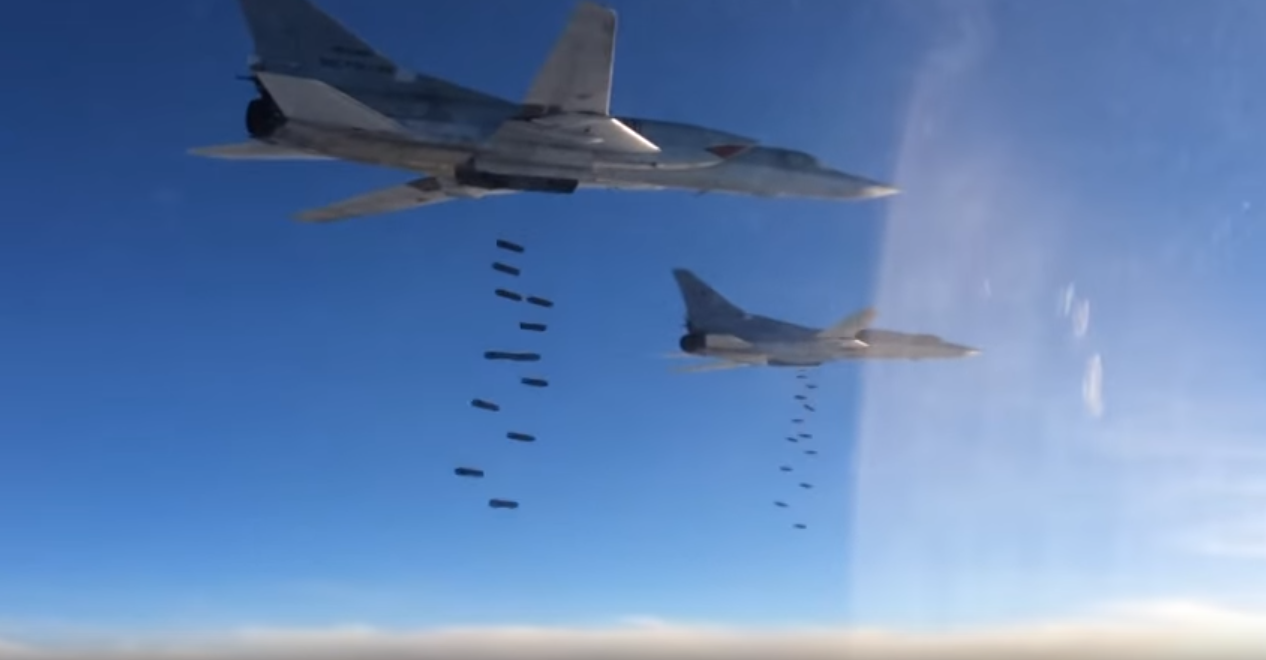Despite what the Kremlin claims, ISIS is still not the main target for Russia’s airstrikes in Syria. Now the US has said it is open to cooperating with Russia if it is willing to change that.
The previous post in our Putin in Syria column can be found here.
The Russian Ministry of Defence has released more video footage from their latest round of air strikes in Syria, which included sorties by strategic bombers for the second day.
Notably, Russia does appear to have stepped up its attacks on ISIS-held territory, having previously made a rather low number of attacks on ISIS when compared to their assault on rebel groups in the west of the country.
This MOD video shows air strikes on oil and gas facilities in ISIS-held territory:
Christiaan Triebert, a graduate student of war studies and intern at the International Centre for Security Analysis, geolocated two of the targets seen in the footage, while another Twitter user, Samir (@obretix) located a third:
All three are in ISIS-controlled areas of the Deir ez-Zor province.
The Syrian Local Coordination Committees (LCC) have also reported casualties from Russian air strikes in this same area.
According to the LCC, 10 were killed and dozens wounded after Russian jets bombed the town of al-Muhassan with cluster weapons. In the nearby town of Khasham the LCC reported two deaths.

The MOD also released a video of bombs striking a large collection of parked oil tankers and other trucks at an undisclosed location:
But it appears that Russia has not diverted all of its attention to ISIS, with reports of air strikes on rebel-held settlements in several regions well outside ISIS control.
According to the LCC, the Russian Air Force today bombed Jisr al-Shughour and Kirkat in Idlib, Kafr Nabudah in Hama, and Jabal al-Akrad in Latakia.

Video purportedly filmed today near Jabal al-Akrad shows columns of bombs falling from the sky:
Compare this with the Russian MOD footage released today of air raids by Tu-22M3 strategic bombers:

Note that the mountains seen in the same video (in a separate shot to the footage of the bomb release) do not appear to be in Latakia. Instead, we believe they may be the Alborz mountains in Iran, along the southern coast of the Caspian Sea, over which the bombers, flying from Russian airfields, must have flown to reach Syria.
Another video purportedly filmed in the same area near Jabal al-Akrad, shows what appears to be larger missile landing, perhaps one of the air-launched cruise missiles Russian Tu-95 and Tu-160 bombers have been using:
The United States and Russia are concluding a series of talks this
week that are focused on Syria, and the timing could not be any more
appropriate. Both nations are conducting airstrikes in Syria, both
Russia and France have been hit by ISIS-related terrorist attacks in the
last month, and the world is demanding a response to the threat.
The United States has thus far only entered into a “deconfliction”
agreement with Russia in order to ensure that Russian and US-coalition
aircraft don’t collide in mid air — or worse, fire on each other. But
their aims are very different. Thus far, while the US and its coalition
are exclusively bombing ISIS targets in both Iraq and Syria, Russia is
only bombing in Syria, and almost all of Russia’s targets are rebel
groups and civilians in areas where ISIS either never controlled or has
been pushed out.In fact, Russian and American interests diverge even
further since Russia has bombed rebel groups which were armed and
trained by the US.
Yesterday, in the wake of Russia’s reluctant announcement that it
was a terrorist attack that brought down a Metrojet airliner in Egypt on
October 31, there was a change in rhetoric — and perhaps direction.
Russia launched expensive cruise missiles from ships and aircraft.
Russia was sending a clear message — as we pointed out before, Russian
cruise missile strikes in Syria are mostly for show.
may have stuck positions inside ISIS-controlled territory yesterday, but
many of Russia’s cruise missiles also hit Ma’arrat al Nouman, a key
city near the front lines of the non-ISIS rebel fight against the Assad
regime:
The US, so far, has echoed this fact — that Russia is more concerned
about fighting to keep Assad in power than it is about fighting
terrorism. US officials have made comments that 80 or 90 percent of
Russian airstrikes have hit non-ISIS targets, for instance.
But in the wake of the Paris attack, is that changing? Wall Street Journal is running the headline “Obama Open to Russia’s Cooperation in Syria If It Centers Attacks on Islamic State.”
President Barack Obama said Wednesday he told Russian President Vladimir Putin during a 35-minute meeting in Turkey earlier this week that if Russia shifts its military strategy in Syria to focus on Islamic State, the U.S. would welcome cooperation with Moscow on an intensified military campaign.
“That is something that we very much want to see,” Mr. Obama said while in the Philippines for a summit.
Mr. Obama also said an agreement on a political resolution in Syria would help pave the way for additional military cooperation. Russia has been a “constructive partner” in diplomatic talks about Syria in Vienna, he said, although the two leaders still disagree on the future of Bashar al-Assad, the Syrian president.
The New York Times is running a similar headline, “Russia Allies With France Against ISIS, Saying Jet That Crashed in Sinai Was Bombed,” but the article casts doubt on whether such cooperation will become a reality:
“The problem has been in their initial military incursion into Syria, they have been more focused on propping up President Assad,” Mr. Obama said, adding that “If in fact he shifts his focus and the focus of his military, to what is the principal threat, which is ISIL, then that is what we want to see.”
Mr. Obama’s comments are the most direct indication that the United States is prepared to work with Russia to counter the Islamic State, which is also known as ISIS, ISIL or Daesh.
The president suggested that American officials remained skeptical about whether Mr. Putin would shift his focus toward the terrorist group, even in the wake of the Paris attacks.
But he said that the Russians have been “a constructive partner” during diplomatic talks in Vienna last week, where foreign ministers agreed to a path to a cease-fire in Syria and an eventual political transition.
Russia is also not utilizing precision bombing. Activists on the ground have reported, and international NGOs and media outlets have confirmed, widespread civilian casualties, the destruction of hospitals, and the use of incendiary weapons since Russian airstrikes have started. Here is video, released today by the Russian Ministry of Defense news channel TV Zvezda. Notice that the Russian aircraft are dropping bombs from above the clouds. It’s hard to imagine how these unguided munitions could accurately target anything from this altitude. Civilian casualties are one reason cited by the US military for being reluctant to cooperate with Russia on strikes inside Syria: